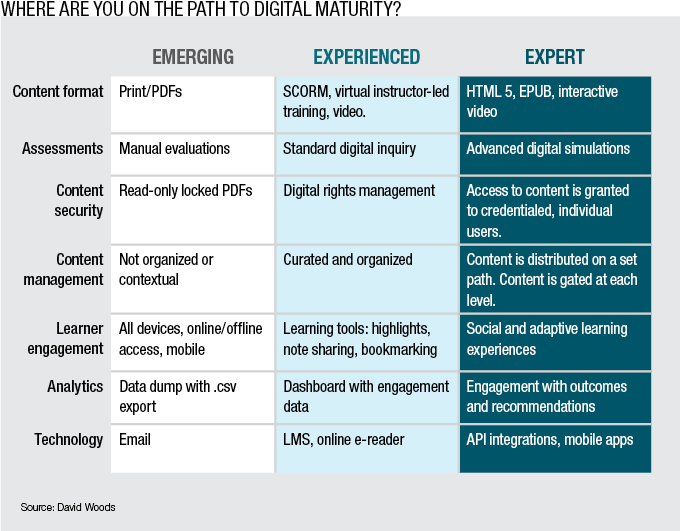The landscape of employee learning and engagement is constantly shifting, but what does that mean for organizations that are just beginning their digital learning journey?
Artificial intelligence, adaptive learning and virtual reality: While these technologies are exciting for the potential they bring in training employees and offering more engaging experiences, there are many organizations that are still stuck in outdated modalities for whom such leaps are unthinkable. Many organizations are still printing and shipping manuals and binders all over the country or even the world to get information to their people.
But it doesn’t have to be that way.
In many industries, small, incremental changes can often be more practical to accomplish at speed than large, sweeping changes, and the same can be true for learning and development departments that feel stuck in their current training methods. The good news is that small steps along the digital learning path can lead to significant changes in your learners’ lives and in your training department’s efficacy.
Dusty binders and manuals are a thorn in the heel of many a CLO. Here’s where to start to bring your training into the digital age.
1: Go Digital
There are numerous ways to digitize your existing content. Depending on your existing file types, simple conversions into a PDF format can yield a variety of delivery options where content can easily be rendered on either a desktop or a mobile device. Different providers offer different functionality, but core functionality — such as the ability to easily search and find relevant content — is important, particularly if your training is often used by employees for reference purposes.
2: Go Mobile
For a learning and development professional who has not shifted into digital delivery, this concept may seem just as large and sweeping as something like virtual reality. Industries such as hospitality, insurance, and construction and engineering, to name a few, have numerous employees out in the field, not confined to a desk. With less than half of today’s learners located onsite at an organization and almost 30 percent of learning occurring outside physical walls, according to Brandon Hall Group’s 2017 “Extended Enterprise Learning” study, mobile and offline access is imperative to modern training and business goals.
Mobile meets your deskless workers where they are and in a way that they are used to learning. After all, in our personal lives if we need to find an answer quickly or reference something as simple as a recipe, the first thing we do is pull up an internet search on our phone. Enabling modern employees who are not tied to a desk to utilize their most essential personal device for work is a critical factor to consider in how training reaches your workforce.
3: Get Contextual
While mobile learning provides learners instant access, it also allows for deeper, richer learning experiences. Provide learners the opportunity to receive their learning in an environment with the appropriate context. We can look at the mobile knowledge building process, or mKBP, model to gain further insight around how our geographic location actually impacts the learning experience. An expansion of Gerry Stahl’s collaborative knowledge building process model, which divides knowledge building into personal understanding and social knowledge building, the mKBP places importance on the context of an individual’s physical location.
For an employee working in a kitchen, for example, standards and procedures regarding kitchen safety and equipment operation are often delivered on the job in order to provide the appropriate context. It makes little sense to provide this type of training to an individual via a remotely located computer or an in-person classroom session — it’s much more effective in a hands-on context. Mobile learning can provide this type of deep, rich learning that aids knowledge retention.
Mobile learning also reinforces the concept of just-in-time learning. Organizations that have employees on the front line, out in the field or on job sites do not have the luxury of providing digital training materials, which require a computer and an internet connection. For many of these organizations, reaching employees with critical information that is easy to reference can be done by ensuring the learner has mobile access.
Mobile access is important for those employees who may not be receiving specific training but are forced to solve a problem in an urgent situation using company information. Take the case of claims adjusters for insurance companies. Often onsite at personal or commercial properties, it is beneficial for these employees to easily access key information related to the property they are evaluating. Thumbing through a binder for proper regulations can be time consuming, but searching and referencing the content on a mobile device at the point of need is far more efficient. Being able to outline procedures and instructions and review regulations can be extremely effective for learners and result in a better experience for clients.
And don’t forget the folks in the field who are working in a warehouse, basement or just beyond the reach of a cell tower. These individuals may need to access their digital materials offline, as they may lack access to the internet or a network. Mobile also allows for learning and reference or spontaneous collaboration among peers during a public transportation commute.
Even if you still utilize a classroom, your learners should be able to access your content when necessary beyond the classroom.
4: Get Interactive
The next step beyond delivering static content to employees on a mobile device at their point of need is to improve learner engagement and interaction with the content. There are two ways to get started: Make the content itself more engaging and review the features of the mobile platform.
Taking print content and delivering it in a digital format is a great first step, but taking that static text and adding more engaging and enriching features to it can greatly impact the learning experience. For example, the addition of instructional videos to your training materials can provide users with key visuals that reinforce written text.
Imagine being a new employee in a warehouse and having instructional videos detail key pieces of equipment, workplace safety and operational procedures. These videos reinforce the written text and provide visual learners with important information on their mobile device at their point of need.
In addition to video, formative assessments and quizzes can be added to the content to allow a learner to check his or her understanding. If you consider adding assessments to your content, you should always evaluate whether those scores need to be recorded or tracked. Quizzing elements can provide organizations with a picture of how well an employee may be grasping particular elements of the new job and give you a sense of whether the materials you are providing are effective in their presentation.
While offering dynamic content can help learners become more engaged, there are also elements of the digital platform one chooses that can provide additional learner engagement. For instance, many digital platforms will allow the learner to take notes and add highlights to text for important information they may need to reference later. Some digital platforms also include social elements, which may allow management to share their annotations or portions of text or video with their colleagues. Social elements that can promote communication among teams drive engagement and foster a learning environment in a way that standard printed materials cannot.
Reporting and analytics were found to be the most important characteristics to support an extended learning system according to the Brandon Hall study. What type of analytics to gather depends on what you plan to do with the data. To measure true learner engagement, you need to know how they’re interacting with your content. Are they reading/viewing it? Are they passing assessments, highlighting notes or sharing with colleagues?
Big Things Start Small
You have to start where you are. If your L&D world consists of binders and print manuals, look at the first small steps you can take into the digital realm. You’ll likely find it immediately rewarding and a great way to start down new roads in your organization’s learning culture.
You don’t have to shoot for the moon in your first attempts at transforming and changing your learning programs. Many great changes that we experience are a result of small, incremental changes; taking those first small steps can push you in the right direction toward training a more modern and engaged workforce.
















